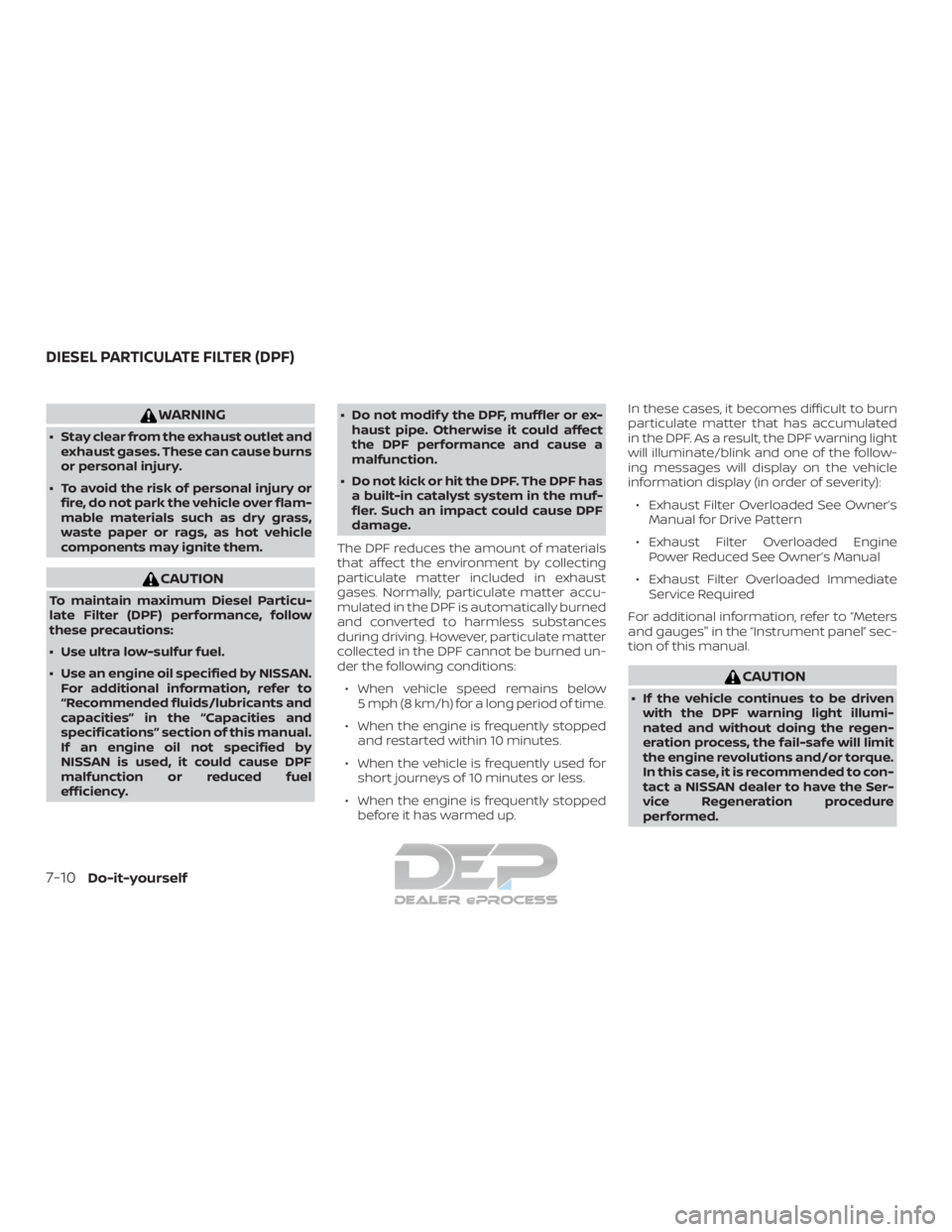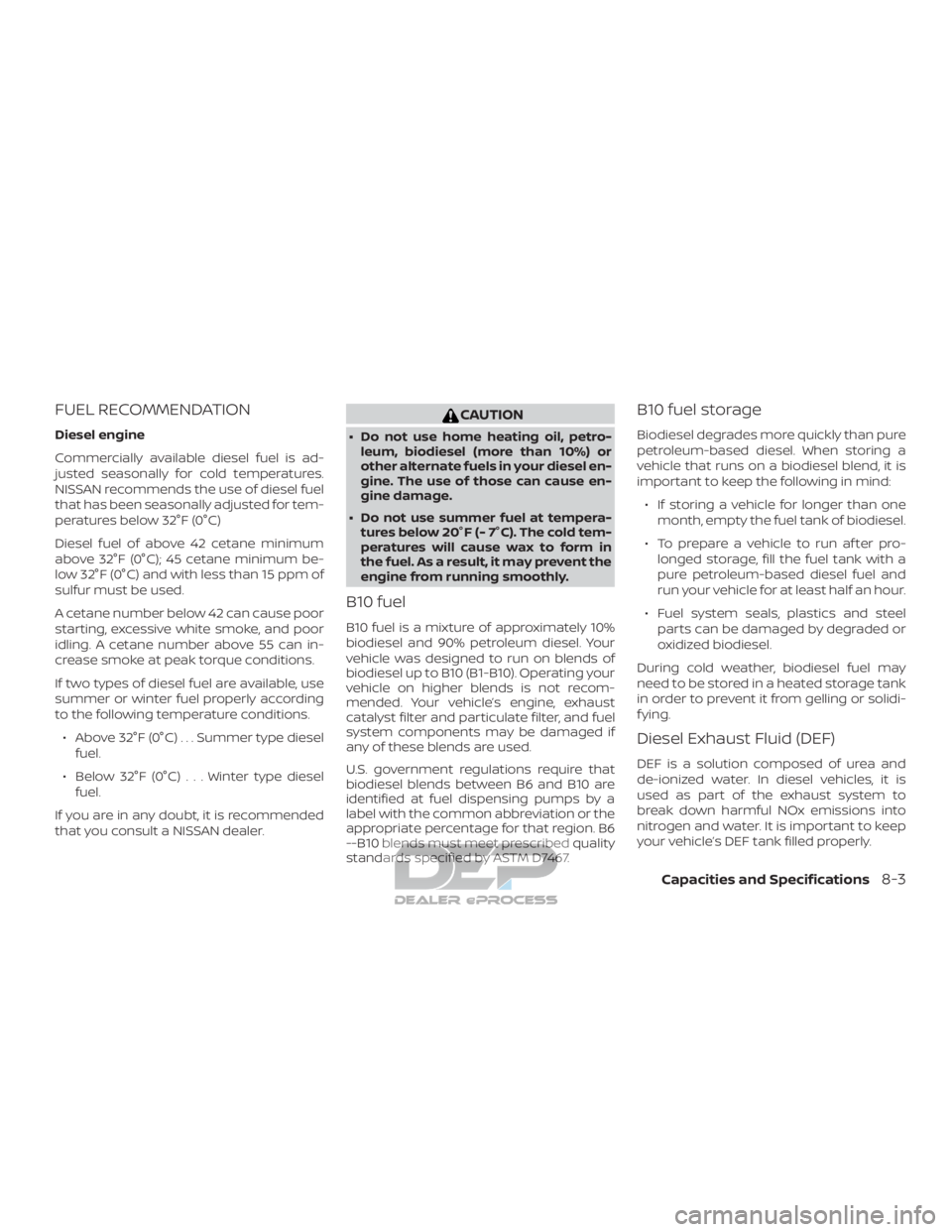Page 660 of 682

NOTE:
The factory fill oil may include a red dye
that is added for manufacturing quality
processes. The dye makes the oil appear
to be red. This is normal. The red dye will
be flushed from the engine af ter ap-
proximately 4–5 oil changes.1. Park the vehicle on a level surface and apply the parking brake.
2. Start the engine and let it idle until it reaches operating temperature, then
turn it off.
3. Remove the oil filler cap
�Aby turning it
counterclockwise.
4. Place a large drain pan under the drain plug
�B.
5. Remove the drain plug
�Bwith a
wrench by turning it counterclockwise
and completely drain the oil.
Remove and replace the engine oil fil-
ter at this time. For additional informa-
tion, refer to “Changing engine oil filter”
in this section.
∙ Waste oil must be disposed of prop-
erly.
∙ Check your local regulations.
WARNING
∙ Prolonged and repeated contact with
used engine oil may cause skin
cancer.
∙ Try to avoid direct skin contact with used oil. If skin contact is made, wash
thoroughly with soap or hand cleaner
as soon as possible.
∙ Keep used engine oil out of reach of children.
CAUTION
Be careful not to burn yourself. The en-
gine oil may be hot.
6. Clean and reinstall the drain plug. Se- curely tighten the drain plug with a
wrench. Do not use excessive force.
Drain plug tightening torque: 25 f t-lb (34 N·m) 7. Refill engine with recommended oil
through the oil filler opening, then install
the oil filler cap securely.
For additional information on drain
and refill capacity, refer to “Recom-
mended fluids/lubricants and capaci-
ties” in the “Capacities and specifica-
tions” section of this manual.
The drain and refill capacity depends
on the oil temperature and drain time.
Use these specifications for reference
only. Always use the dipstick to deter-
mine when the proper amount of oil is
in the engine.
8. Start the engine. Check for leakage around the drain plug and oil filter. Cor-
rect as required.
9. Turn the engine off and wait more than 10 minutes. Check the oil level with the
dipstick. Add engine oil if necessary.
NOTE:
For additional information on resetting
the oil control system, refer to “Resetting
the oil control system” in the “Instrument
panel” section of this manual.
Do-it-yourself7-7
Page 663 of 682

WARNING
∙ Stay clear from the exhaust outlet andexhaust gases. These can cause burns
or personal injury.
∙ To avoid the risk of personal injury or fire, do not park the vehicle over flam-
mable materials such as dry grass,
waste paper or rags, as hot vehicle
components may ignite them.
CAUTION
To maintain maximum Diesel Particu-
late Filter (DPF) performance, follow
these precautions:
∙ Use ultra low-sulfur fuel.
∙ Use an engine oil specified by NISSAN.For additional information, refer to
“Recommended fluids/lubricants and
capacities” in the “Capacities and
specifications” section of this manual.
If an engine oil not specified by
NISSAN is used, it could cause DPF
malfunction or reduced fuel
efficiency. ∙ Do not modif y the DPF, muffler or ex-
haust pipe. Otherwise it could affect
the DPF performance and cause a
malfunction.
∙ Do not kick or hit the DPF. The DPF has a built-in catalyst system in the muf-
fler. Such an impact could cause DPF
damage.
The DPF reduces the amount of materials
that affect the environment by collecting
particulate matter included in exhaust
gases. Normally, particulate matter accu-
mulated in the DPF is automatically burned
and converted to harmless substances
during driving. However, particulate matter
collected in the DPF cannot be burned un-
der the following conditions: ∙ When vehicle speed remains below 5 mph (8 km/h) for a long period of time.
∙ When the engine is frequently stopped and restarted within 10 minutes.
∙ When the vehicle is frequently used for short journeys of 10 minutes or less.
∙ When the engine is frequently stopped before it has warmed up. In these cases, it becomes difficult to burn
particulate matter that has accumulated
in the DPF. As a result, the DPF warning light
will illuminate/blink and one of the follow-
ing messages will display on the vehicle
information display (in order of severity):
∙ Exhaust Filter Overloaded See Owner’s Manual for Drive Pattern
∙ Exhaust Filter Overloaded Engine Power Reduced See Owner’s Manual
∙ Exhaust Filter Overloaded Immediate Service Required
For additional information, refer to “Meters
and gauges" in the “Instrument panel” sec-
tion of this manual.
CAUTION
∙ If the vehicle continues to be driven with the DPF warning light illumi-
nated and without doing the regen-
eration process, the fail-safe will limit
the engine revolutions and/or torque.
In this case, it is recommended to con-
tact a NISSAN dealer to have the Ser-
vice Regeneration procedure
performed.
DIESEL PARTICULATE FILTER (DPF)
7-10Do-it-yourself
Page 668 of 682

FUEL RECOMMENDATION
Diesel engine
Commercially available diesel fuel is ad-
justed seasonally for cold temperatures.
NISSAN recommends the use of diesel fuel
that has been seasonally adjusted for tem-
peratures below 32°F (0°C)
Diesel fuel of above 42 cetane minimum
above 32°F (0°C); 45 cetane minimum be-
low 32°F (0°C) and with less than 15 ppm of
sulfur must be used.
A cetane number below 42 can cause poor
starting, excessive white smoke, and poor
idling. A cetane number above 55 can in-
crease smoke at peak torque conditions.
If two types of diesel fuel are available, use
summer or winter fuel properly according
to the following temperature conditions.∙ Above 32°F (0°C) . . . Summer type diesel
fuel.
∙ Below 32°F (0°C) . . . Winter type diesel fuel.
If you are in any doubt, it is recommended
that you consult a NISSAN dealer.
CAUTION
∙ Do not use home heating oil, petro- leum, biodiesel (more than 10%) or
other alternate fuels in your diesel en-
gine. The use of those can cause en-
gine damage.
∙ Do not use summer fuel at tempera- tures below 20°F (- 7°C). The cold tem-
peratures will cause wax to form in
the fuel. As a result, it may prevent the
engine from running smoothly.
B10 fuel
B10 fuel is a mixture of approximately 10%
biodiesel and 90% petroleum diesel. Your
vehicle was designed to run on blends of
biodiesel up to B10 (B1-B10). Operating your
vehicle on higher blends is not recom-
mended. Your vehicle’s engine, exhaust
catalyst filter and particulate filter, and fuel
system components may be damaged if
any of these blends are used.
U.S. government regulations require that
biodiesel blends between B6 and B10 are
identified at fuel dispensing pumps by a
label with the common abbreviation or the
appropriate percentage for that region. B6
--B10 blends must meet prescribed quality
standards specified by ASTM D7467.
B10 fuel storage
Biodiesel degrades more quickly than pure
petroleum-based diesel. When storing a
vehicle that runs on a biodiesel blend, it is
important to keep the following in mind:
∙ If storing a vehicle for longer than one month, empty the fuel tank of biodiesel.
∙ To prepare a vehicle to run af ter pro- longed storage, fill the fuel tank with a
pure petroleum-based diesel fuel and
run your vehicle for at least half an hour.
∙ Fuel system seals, plastics and steel parts can be damaged by degraded or
oxidized biodiesel.
During cold weather, biodiesel fuel may
need to be stored in a heated storage tank
in order to prevent it from gelling or solidi-
f ying.
Diesel Exhaust Fluid (DEF)
DEF is a solution composed of urea and
de-ionized water. In diesel vehicles, it is
used as part of the exhaust system to
break down harmful NOx emissions into
nitrogen and water. It is important to keep
your vehicle’s DEF tank filled properly.
Capacities and Specifications8-3